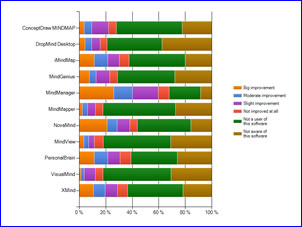 In December, I asked the readers of this blog to participate in a brief survey. Its purpose was to identify the most improved mind mapping program of 2009, to celebrate the awesome advances that the developers of this type of productivity software have made.
In December, I asked the readers of this blog to participate in a brief survey. Its purpose was to identify the most improved mind mapping program of 2009, to celebrate the awesome advances that the developers of this type of productivity software have made.
The Most Improved Mind Mapping Software of 2009 is (drumroll)… MindManager.
The top 5 most improved programs, based on 215 responses, were:
- MindManager (26.0%)
- NovaMind (20.9%)
- iMindMap (11.2%)
- PersonalBrain (11.2%)
- XMind (10.7%)
To view the full results as a stacked bar chart, please click on the image above.
It’s no surprise to me that MindManager was ranked number one. It has tremendous name recognition in this niche, and after some incremental improvements and a mediocre attempt at creating a collaboration tool (Mindjet Connect) in 2008, the company finally got it right in 2009 with Catalyst, a polished, full-featured collaboration environment that is really quite good.
This survey also shows us which programs are coming on strong as innovators. Gideon King and his development team at NovaMind have been relentless in pushing the envelope in terms of what’s possible with mind mapping software. It’s really cool to see that you, the readers of this blog, recognize their efforts, by NovaMind the second most improved mind mapping program in 2009 – and, significantly, only 6% behind MindManager!
iMindMap and XMind are fairly new entrants to the field of mind mapping software, making it very impressive that they came in number 3 and number 5. It appears that users and fans of mind mapping software recognize their developers’ commitment to innovation, too!
Finally, the survey results demonstrate that some of the developers of mind mapping software need to do some work in building name recognition. DropMind Desktop (37.7%), MindView (31.2%), VisualMind (30.7%) and MindGenius (27.9%) led the pack in terms of software programs that respondents weren’t aware of. DropMind is fairly new, and MindView was formerly OpenMind (the name change took place in early 2009), so those relatively high numbers are easy to understand. The other two programs have been around for a while, and I’m not sure why respondents aren’t aware of them.
Thanks to all of you who participated in this interesting survey!

Leave a Reply